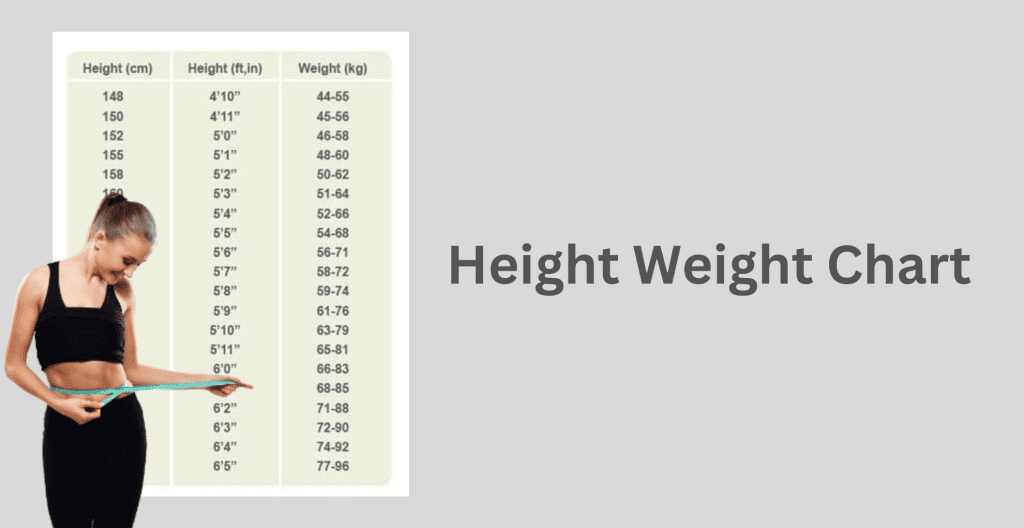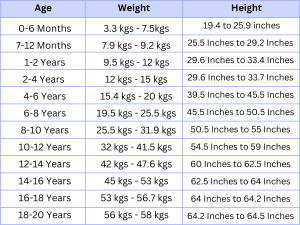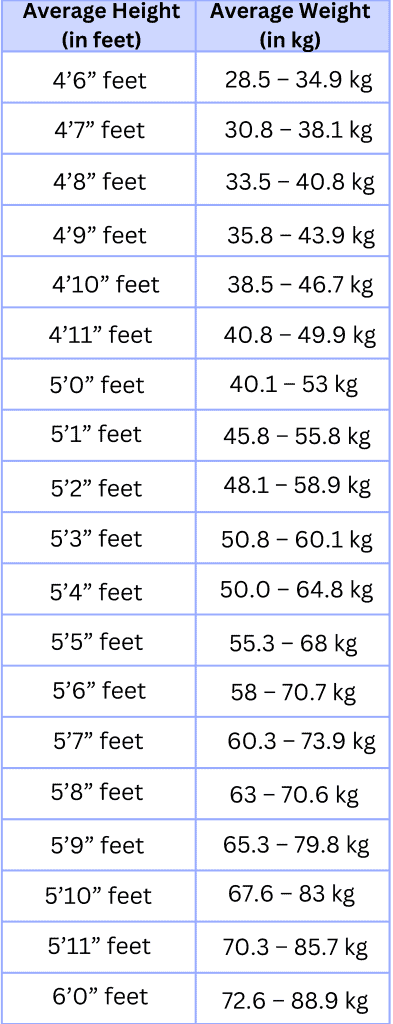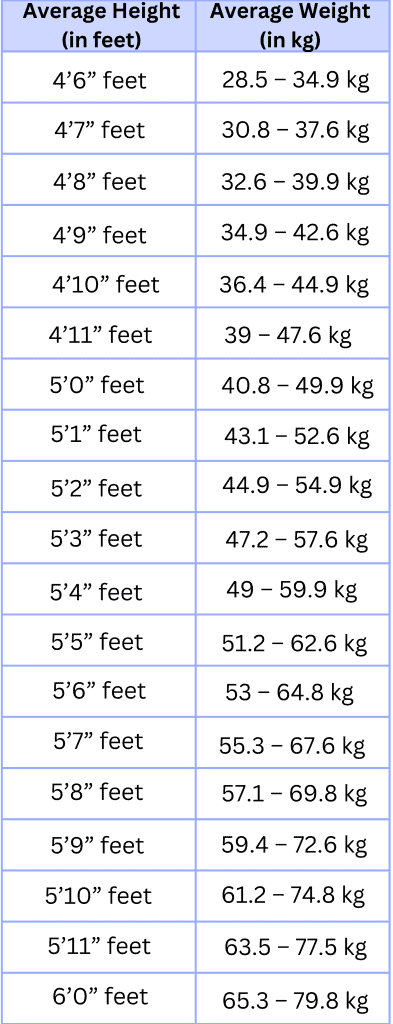A height weight chart is a tool that shows the recommended weight range for a person based on their height. It helps assess if a person is underweight, normal weight, overweight, or obese.
Interpreting the chart involves finding where a person’s height and weight intersect, indicating their corresponding body mass index (BMI). A BMI within a certain range is considered healthy, while values outside that range may signal potential health risks. Monitoring the height-weight chart is beneficial for tracking changes in body weight over time, helping individuals and healthcare professionals identify trends and make informed decisions about diet and exercise. It promotes awareness of healthy weight ranges and encourages lifestyle choices that contribute to overall well-being.
Interpretation of Height and Weight Chart
Interpreting the height weight chart is essential to understand whether an individual is underweight, overweight, or within a healthy weight range based on their height. Let’s define these categories:
1. Underweight: If a person’s weight falls below the recommended range for their height, they are considered underweight. Being underweight can indicate possible malnutrition or insufficient caloric intake, which may lead to various health issues, such as weak immune function, nutrient deficiencies, and decreased energy levels.
2. Overweight: According to the height weight chart, if a person’s weight exceeds the recommended range for their height, they are classified as overweight. Excess weight can increase the risk of developing chronic conditions like diabetes and hypertension and have adverse effects on joint health as well.
3. Healthy Weight: Falling within the recommended height weight chart range indicates a healthy weight. This category is associated with lower health risks, increased energy levels, and better overall well-being. Maintaining a healthy weight promotes longevity and reduces the likelihood of obesity-related health complications.
It’s important to note that factors like body composition, muscle mass, and individual differences can influence a person’s weight according to height.
Height and Weight Chart According to Age
A Height and Weight Chart according to Age is a specialized tool designed to assess an individual’s growth and development by taking into account both age and physical stature. Particularly used for children and adolescents, these charts provide a comprehensive overview of how a person’s weight corresponds to their age, allowing for a more accurate evaluation of growth patterns.
Height Weight Chart For Males
For all the men out there, here is the height-weight chart for Males. You can have a look at this chart and get to know whether or not your current weight is within the recommended weight range.
Height Weight Chart For Women
Here is the height weight chart for Females. So for all the women who are curious to know their ideal weight according to their height, this is the chart you should carefully go through!
How To Use A Height Weight Chart?
Using the height weight chart is an easy process that can help individuals assess whether or not their weight is within a healthy range based on their height. Here’s a step-by-step guide on how to use the chart effectively:
Step 1: Measure Your Height: Begin by measuring your height accurately. Use a measuring tape or stand against a wall with a ruler to determine your height in either feet and inches or centimetres.
Step 2: Determine Your Weight: Measure your weight using a scale. Make sure to weigh yourself without shoes and avoid wearing heavy clothing for accurate results.
Step 3: Locate Your Position on the Chart: Once you have your height and weight measurements, find the corresponding position on the height weight chart. The chart typically consists of a grid with height listed on one axis and weight on the other.
Step 4: Interpret Your Position: Once you locate your position on the height weight chart, you can interpret the result. There are generally three main categories that we have discussed in the previous section; Underweight, Normal Weight, and Overweight.
Step 5: Consider Other Factors: While the height weight chart provides a general guideline, remember that individual variations exist. Factors such as muscle mass, body frame size, and age may influence your ideal weight range. Therefore, it’s essential to consider other methods of measurement, such as the BMI calculator, body fat percentage, and waist-to-hip ratio, for a more comprehensive assessment.
Step 6: Set Realistic Goals: If you find yourself in the underweight, overweight, or obese category, it’s essential to set realistic weight management goals. Consult with healthcare professionals or certified fitness experts to develop a personalized plan, such as 7 days diet plan for weight loss that includes a balanced diet, regular exercise, and lifestyle adjustments to achieve and maintain a healthy weight.
The height weight chart is a valuable tool to gain insights into whether your weight is proportionate to your height. It provides a starting point to assess your weight status.
Benefits of Using a Height and Weight Chart
The height weight chart is important in understanding and assessing an individual’s body composition and overall health. Let’s explore the key reasons why this height weight chart can help you;
- Health Assessment: The height weight chart serves as a simple and quick tool to assess whether an individual’s weight is proportionate to their height. It helps identify potential weight-related health issues, such as underweight or overweight conditions and the average weight for height in kgs. Further, schools can use the height and weight chart according to age to assess students’ overall health.
- Identifying Underweight Individuals: For some people, being underweight may indicate malnutrition, inadequate nutrient intake, or certain underlying health conditions. The specific weight chart helps identify individuals who may need proper nutrition and medical attention to achieve a healthier weight.
- Detecting Overweight and Obesity: The height weight chart is instrumental in recognizing overweight and obesity, both of which are risk factors for various chronic diseases like heart disease, diabetes, and hypertension. By identifying individuals in these categories, appropriate interventions and lifestyle changes can be recommended to improve their health outcomes.
- Preventing Health Complications: Maintaining a healthy weight within the recommended weight chart range can reduce the risk of numerous health complications. By using the height weight chart, individuals can become aware of their weight status and take proactive measures to prevent potential health issues.
- Personalized Guidance: The weight chart is a useful starting point for individuals seeking to set realistic health and fitness goals. Based on their position on the height weight chart, they can seek personalized guidance from healthcare professionals, nutritionists, or fitness experts to develop tailored plans for weight management and overall well-being. Engaging in specific exercises to increase height, such as stretching and hanging routines, can positively impact your overall stature by promoting spine elongation and bone health.
- Tracking Progress: For those on a weight management journey, the height weight chart is a valuable tool to track their progress over time. Regular check-ins with the weight chart and learning from weight loss blogs can help individuals stay motivated and make necessary adjustments to their lifestyle and habits.
- Public Health Tool: On a broader scale, height weight charts are essential for public health initiatives and epidemiological research. When planning a fitness program, it’s essential to consider individual differences, including the information from the height weight chart to age, for accurate goal setting
In conclusion, the height weight chart is crucial in promoting individual and public health by enabling early detection of weight-related concerns, guiding appropriate interventions, and encouraging oneself to maintain a balanced and healthy body composition.
How is Weight According to Height Calculated?
Ideal weight is often calculated using various methods, with the most common one being the Body Mass Index (BMI). The BMI is a numerical value derived from an individual’s weight to their height. Here’s how the BMI is calculated and how it can be used to determine ideal weight:
BMI = Weight (kg) / (Height (m) * Height (m))
Method to Calculate BMI:
- Measure Your Weight: Use a scale to measure your weight in kilograms (kg).
- Measure Your Height: Use a measuring tape or a stadiometer to measure your height in meters (m).
- Calculate BMI: Plug your weight and height measurements into the BMI formula. Divide your weight in kilograms by the square of your height in meters.
Example: Suppose your weight is 70 kg and your height is 1.75 m.
BMI = 70 kg / (1.75 m * 1.75 m) = 22.86
Interpreting BMI:
Once you have calculated your BMI, you can interpret it using standard categories:
- Underweight: BMI less than 18.5
- Normal Weight: BMI 18.5 – 24.9
- Overweight: BMI 25 – 29.9
- Obesity (Class I): BMI 30 – 34.9
- Obesity (Class II): BMI 35 – 39.9
- Obesity (Class III): BMI 40 or higher
While the BMI rate is a healthy and common choice, teenagers can use the height and weight chart according to age to assess their overall health and implement health programs accordingly.
Other ways to Determine Weight According to Height
When determining the ideal weight according to height, there are several alternative methods other than the height weight chart. While the Body Mass Index (BMI) is commonly used, there are other lesser-known and effective ways as well. Here are some other effective ways to measure average weight for height in kgs;
- BMI Calculator
- Waist-To-Hip Ratio (WHR)
- Waist-To-Height Proportion
- Percentage Of Body Fat
- Body Type And Waist Circumference
These methods are usually recommended for adults, so parents can use the height and weight chart according to age as a reference to monitor their child’s growth and ensure they are developing within the appropriate range. Let’s discuss each of them and see how you can find your average weight for height in kgs.
1. BMI Calculator
BMI is a widely used and straightforward method to assess whether an individual’s weight is within a healthy range for their height. It is calculated by dividing a person’s weight (in kilograms) by the square of their height (in meters). The resulting number is then compared to standard BMI categories to determine whether the individual is underweight, normal weight, overweight, or obese.
BMI (Body Mass Index) is calculated by dividing an individual’s weight in kgs by the square of their height in meters. The formula is: BMI = Weight (kg) divided by (Height (m) * Height (m))
Example: Let’s say an individual weighs 70 kilograms and their height is 1.75 meters.
BMI = 70 kg / (1.75 m * 1.75 m) = 22.86
Based on the standard BMI categories, a BMI of 22.86 falls within the “Normal Weight” range.
2. Waist-To-Hip Ratio (WHR)
The waist-to-hip ratio is another valuable measurement that assesses fat distribution in the body. It involves dividing the waist circumference by the hip circumference. Those with higher fat concentrations around the waist (apple-shaped) may be at a greater risk of developing chronic diseases compared to those who have stored fat around the hips and thighs (pear-shaped). Thus, measuring WHR is significant to know where we store fat because it can impact our health.
The Waist-to-Hip Ratio to find the average weight for height in kg is determined by dividing the waist circumference by the hip circumference. The formula is: WHR = Waist Circumference (cm) divided by Hip Circumference (cm)
Example: Consider a person with a waist circumference of 80 centimetres and a hip circumference of 100 centimetres.
WHR = 80 cm / 100 cm = 0.8
A WHR of 0.8 or less is generally considered healthy, indicating a lower risk of obesity-related health conditions.
3. Waist-To-Height Proportion
The waist-to-height ratio is a simple yet effective tool to determine whether a person has a healthy distribution of body fat. To calculate it, divide the waist circumference by the height. Experts suggest that a waist-to-height ratio of 0.5 or less is associated with a lower risk of obesity-related health conditions.
To measure the waist-to-high ratio to find the average weight for height in kgs, divide the waist circumference by the individual’s height. The formula is: Waist-to-Height Ratio = Waist Circumference (cm) / Height (cm)
Example: For an individual with a waist circumference of 75 cm and a height of 165 cm:
Waist-to-Height Ratio = 75 cm / 165 cm = 0.45
A Waist-To-Height Ratio of 0.5 or less is associated with a lower risk of obesity-related health issues.
4. Percentage Of Body Fat
Measuring the percentage of body fat provides a more precise understanding of a person’s body composition. It can be done using various methods, including bioelectrical impedance, dual-energy X-ray absorptiometry (DEXA), or skinfold callipers. Knowing the percentage of body fat helps in setting realistic weight goals and assessing overall health status.
Measuring the percentage of body fat requires specialized equipment like bioelectrical impedance, DEXA, or skinfold callipers, so you can’t do this at home to find the average weight for height in kgs.
5. Body Type And Waist Circumference
Consideration of body type and waist circumference is essential. Different body types may have varying ideal weight ranges. Additionally, excess fat around the waist (visceral fat) is associated with a higher risk of health problems. Measuring waist circumference can provide insights into abdominal fat levels and associated health risks.
While there’s no strict formula to measure this, understanding body types and measuring waist circumference are crucial aspects of assessing ideal weight. Example:
- For an individual with an “apple-shaped” body type, the waist circumference might be 90 cm.
- For another individual with a “pear-shaped” body type, their waist circumference might be 80 cm.
Major Factors that Affect Weight
A combination of factors, including diet, lifestyle, genetics, and environmental factors influences weight. Here are some of the key factors that can affect weight:
1. Diet: The type and quantity of food you consume are crucial in weight management. A balanced diet that includes a variety of nutrient-dense foods, such as fruits, vegetables, whole grains, lean proteins, and healthy fats, can support weight loss or maintenance. On the other hand, excessive consumption of sugary, high-calorie, and processed foods can lead to weight gain.
2. Physical Activity: Regular physical activity helps burn calories and improves overall fitness. Engaging in aerobic exercises, strength training, and other forms of physical activity can aid in weight loss and weight maintenance. An ideal weight calculator can assist you in determining a healthy weight range based on your height, providing a useful reference for maintaining the level of physical activity essential for well-being.
3. Metabolism: Metabolism refers to the rate at which your body burns calories to produce energy. Metabolic rate can be influenced by age, sex, muscle mass, and genetics. Individuals with a higher metabolic rate tend to burn more calories even at rest.
4. Genetics: Genetic factors can influence how your body stores and processes fat. Some people may have a genetic predisposition to gain weight more easily than others, even with similar dietary and activity levels.
5. Hormones: Hormones play a significant role in regulating appetite, metabolism, and fat storage. Hormonal imbalances, such as insulin resistance or thyroid disorders, can impact weight management. Consider using a height weight chart for females and males to understand your target weight range for optimal health.
6. Stress: Chronic stress can lead to emotional eating and affect hormone levels, which may contribute to weight gain. Finding healthy ways to manage stress is essential for weight management.
7. Sleep: Inadequate sleep can disrupt hormonal balance and increase cravings for unhealthy foods, leading to weight gain. Quality sleep is crucial for overall health and weight management.
8. Eating Habits: Eating behaviors, such as emotional eating, mindless eating, and eating in response to external cues, can influence calorie intake and weight.
Tips to Maintain Weight According to Height
The height weight chart can help you identify if your weight is healthy or not. The next step is to maintain a healthy weight if you surpass the healthy range given in the height weight chart. Maintaining an ideal weight is crucial for overall health and well-being. Here are some effective tips to help you achieve and sustain your ideal weight:
- Follow a Healthy Diet Plan
- Be on Calorie Deficit Diet Plan
- Embrace Active Habits
- Reduce Stress
- Take adequate rest
Let us look at each of these in depth.
1. Follow A Healthy Diet Plan
A healthy and balanced diet is the cornerstone of weight management. Incorporate a variety of nutrient-dense foods, including fruits, vegetables, whole grains, lean proteins, and healthy fats. Avoid excessive consumption of sugary and processed foods, as they can lead to weight gain and negatively impact overall health. Portion control is vital, so pay attention to serving sizes to avoid overeating.
2. Be On Calorie Deficit Diet Plan
To lose weight, create a calorie deficit by consuming low-calorie foods. Track your daily calorie intake and ensure it aligns with your weight loss goals. However, remember that extreme calorie restriction can be harmful to your health and metabolism. Aim for a moderate calorie deficit and focus on the quality of food you eat.
3. Embrace Active Habits
Incorporate regular physical activity into your daily routine. Engage in a mix of cardiovascular exercises, such as walking, jogging, cycling, or swimming, along with strength training exercises to build muscle and boost metabolism. Find activities you enjoy to make exercise a sustainable part of your lifestyle. Aim for at least 150 minutes of moderate-intensity exercise or 75 minutes of vigorous-intensity exercise per week.
4. Reduce Stress
Chronic stress can lead to emotional eating and weight gain. Practice stress-reducing techniques, such as meditation, deep breathing exercises, yoga, or spending time in nature. Prioritize self-care and make time for activities that bring you joy and relaxation.
5. Take Adequate Rest
Proper sleep is essential for weight management and overall health. Lack of sleep can disrupt hormones that regulate hunger and appetite, leading to overeating. Aim for 7-9 hours of quality sleep each night to support your weight loss efforts.
Impact Of Being Overweight
Once you use a height weight chart, and if your weight is more than the healthy weight range, it is categorized as overweight. The impact of being overweight extends far beyond appearance, significantly affecting both physical and mental health. Let us look at the impact of being overweight;
1. Chances Of Mental Illness
The relationship between obesity and mental health is complex and significant. People struggling with excess weight often face social stigmatization and dissemination, leading to emotional distress. This can contribute to the development of mental illnesses such as depression, anxiety, and low self-esteem.
2. Low On Energy
Carrying excess weight demands more energy for everyday activities. As a result, overweight individuals may experience chronic fatigue and reduced physical endurance. Simple tasks that are otherwise effortless for those at a healthy weight can become exhausting and challenging. This lack of energy can hinder productivity and overall quality of life.
3. Reduces Lifespan
Numerous studies have established a strong correlation between obesity and reduced lifespan. The excess strain on vital organs, such as the heart, lungs, and liver, can lead to the early onset of life-threatening conditions. Cardiovascular diseases, diabetes, and certain types of cancer are more prevalent in individuals who are overweight, shortening their life expectancy.
4. Higher Medical Costs
The impact of being overweight reaches beyond personal health, affecting healthcare systems and economies. Overweight and obese individuals require more frequent medical attention, including treatments for weight-related health conditions. These increased medical expenses contribute to the rising burden on healthcare resources, affecting both individuals and society.
5. Higher Risk Of Diseases
Obesity is a significant risk factor for a wide range of diseases, leading to a higher prevalence of chronic health conditions. Cardiovascular diseases, such as hypertension, heart disease, and stroke, are more common in individuals with excess weight. Type 2 diabetes, which is closely linked to obesity, poses a substantial health risk and requires ongoing management. Moreover, obesity increases the likelihood of developing certain types of cancer, respiratory problems, and musculoskeletal disorders.
Height Conversion Table
A Height Conversion Table is a reference tool that conveniently converts height measurements between different units, such as feet to meters or inches to centimetres. This table aids in understanding and comparing height across various measurement systems, allowing for seamless communication and comprehension in diverse contexts. It is particularly useful in global settings where different countries may use other units of measurement, ensuring accurate and standardized height representation.
Expert Review on Height Weight Chart
Height weight charts are an in-depth analysis of the correlation between an individual’s height and weight, typically using Body Mass Index (BMI) as a key metric. These charts serve as valuable tools for assessing whether a person falls within a healthy weight range based on their height. Experts evaluate the charts for their accuracy in reflecting population health trends, identifying potential health risks associated with underweight or obesity, and informing recommendations for balanced lifestyles. Continuous scrutiny and updates to these charts are essential to ensure they align with current health standards and provide reliable guidance for individuals and healthcare professionals alike.
References
“. . – definition of . . by The Free Dictionary.” n.d. The Free Dictionary. Accessed January 23, 2024. https://academic.oup.com/bja/article/116/3/319/2566140
“. . – definition of . . by The Free Dictionary.” n.d. The Free Dictionary. Accessed January 23, 2024. https://iopscience.iop.org/article/10.1088/1757-899X/546/5/052063
“Measuring Children’s Height and Weight Accurately At Home | Healthy Weight, Nutrition, and Physical Activity.” n.d. CDC. Accessed January 23, 2024. https://www.cdc.gov/healthyweight/assessing/bmi/childrens_bmi/measuring_children.html
FAQs
What is the correct weight for my height?
Determining the correct weight for your height involves considering various factors, including body composition and individual health. A common tool is the Body Mass Index (BMI), which uses your height and weight to categorize you as underweight, normal weight, overweight, or obese. However, it’s essential to recognize that BMI has limitations, as it doesn’t account for muscle mass or distribution.
How much should a 5’2 female weigh?
For a 5’2 female, a healthy weight can be determined using general guidelines. According to the Centers for Disease Control and Prevention (CDC), a BMI within the range of 18.5 to 24.9 is considered normal weight for adults. For a 5’2 female, this translates to a weight between approximately 101 to 136 pounds. However, it’s important to note that individual factors such as muscle mass, body composition, and overall health should be considered, and consulting with a healthcare professional.
What Is Correct Height and Weight For Age?
The correct height and weight for age vary depending on factors like gender, genetics, and body composition, making it essential to consult a healthcare professional for personalized guidance. Consider using a height and weight chart according to age to learn more about this.
Are Height And Weight Charts Accurate Ways To Measure Health?
Height weight charts can provide a general reference but may not fully capture an individual’s overall health. Other factors like muscle mass and body composition should also be considered. Nonetheless, you can also use a height and weight chart according to age.
How Do I Know Whether I’m Obese In Weight According To Age?
To determine if you’re obese in weight according to age, calculate your BMI and compare it to age-specific BMI percentiles. Consulting a healthcare professional can provide a more accurate assessment. Else, look for the healthy range mentioned in the height and weight chart according to age.











